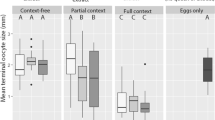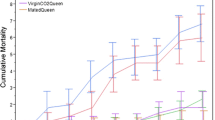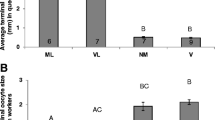Abstract
Reproductive division of labor, a defining feature of social insects, is often regulated by a combination of behavioral and chemical means. It is hypothesized that behavioral interactions play a more important role in regulating reproduction of primitive eusocial species, while pheromones are typically used by large sized, advanced eusocial species. Here we examined if worker reproduction in the primitively eusocial species Bombus impatiens is regulated by brood pheromones. We recently demonstrated that worker egg laying in this species is inhibited by young larvae and triggered by pupae. However, the mechanism by which the brood communicates its presence and whether brood or hunger pheromones are involved remain unknown. We found that workers were behaviorally attracted to pupae over larvae or control in a choice experiment, in line with their reproductive interests. However, odors from larvae or pupae were insufficient to inhibit worker reproduction. We further show that the youngest larvae are particularly vulnerable to starvation, however, despite a slight attraction and fewer eggs laid by workers in the presence of starved compared with fed larvae, these effects were insignificant. Our study demonstrates that workers can differentiate between larvae and pupae, but not between starved and fed larvae based on olfactory information. However, these signals alone do not explain the reduction in worker egg laying previously found. Bumble bee workers may use information from multiple sources or rely solely on behavioral interactions with brood and other females to make decisions about reproduction, in line with their small colony size and simple social organization.







Similar content being viewed by others
References
Alaux C, Jaisson P, Hefetz A (2005) Reproductive decision-making in semelparous colonies of the bumblebee Bombus terrestris. Behav Ecol Sociobiol 59:270–277
Amsalem E, Hefetz A (2010) The appeasement effect of sterility signaling in dominance contests among Bombus terrestris workers. Behav Ecol Sociobiol 64:1685–1694
Amsalem E, Twele R, Francke W, Hefetz A. (2009) Reproductive competition in the bumble-bee Bombus terrestris: do workers advertise sterility? Proc R Soc B 276:1295–1304
Amsalem E, Kiefer J, Schulz S, Hefetz A (2014) The effect of caste and reproductive state on the chemistry of the cephalic labial glands secretion of Bombus terrestris. J Chem Ecol 40:900–912
Amsalem E, Grozinger CM, Padilla M, Hefetz A (2015a) The physiological and genomic bases of bumble bee social behaviour. In: Amro Z, Clement FK (eds) genomics, physiology and behaviour of social insects, Academic Press, Adv In Insect Phys, 48:37–93
Amsalem E, Orlova M, Grozinger CM (2015b) A conserved class of queen pheromones? Re-evaluating the evidence in bumblebees (Bombus impatiens). Proc R Soc B Biol Sci 282:20151800
Amsalem E, Padilla M, Schreiber PM, Altman NS, Hefetz A, Grozinger CM (2017) Do bumble bee, Bombus impatiens, queens signal their reproductive and mating status to their workers? J Chem Ecol 43:563–572
Beshers SN, Fewell JH (2001) Models of division of labor in social insects. Annu Rev Entomol 46:413–440
Bhadra A, Mitra A, Deshpande SA, Chandrasekhar K, Naik DG, Hefetz A, Gadagkar R (2010) Regulation of reproduction in the primitively eusocial wasp Ropalidia marginata: on the trail of the queen pheromone. J Chem Ecol 36:424–431
Bigley WS, Vinson SB (1975) Characterization of a brood pheromone isolated from the sexual brood of the imported fire ant, Solenopsis invicta. Ann Entomol Soc Am 68:301–304
Bloch G, Hefetz A (1999) Reevaluation of the role of mandibular glands in regulation of reproduction in bumblebee colonies. J Chem Ecol 25:881–896
Blomquist GJ, Bagnères A-G (2010) Insect hydrocarbons: biology, biochemistry, and chemical ecology. Cambridge University Press, Cambridge
Boer SPA, Duchateau MJHM (2006) A larval hunger signal in the bumblebee Bombus terrestris. Insect Soc 53:369–373
Cnaani J, Schmid-Hempel R, Schmidt JO (2002) Colony development, larval development and worker reproduction in Bombus impatiens cresson. Insect Soc 49:164–170
Duchateau MJ, Velthuis HHW (1988) Development and reproductive strategies in Bombus terrestris colonies. Behavior 107:186–207
Engel KC, Stokl J, Schweizer R, Vogel H, Ayasse M, Ruther J, Steiger S (2016) A hormone-related female anti-aphrodisiac signals temporary infertility and causes sexual abstinence to synchronize parental care. Nat Commun 7:11035
Fletcher DJC, Ross KG (1985) Regulation of reproduction in eusocial hymenoptera. Annu Rev Entomol 30:319–343
Funaro CF, Boroczky K, Vargo EL, Schal C (2018) Identification of a queen and king recognition pheromone in the subterranean termite reticulitermes flavipes. Proc Natl Acad Sci U S A 115:3888–3893
Godfray HCJ (1991) Signalling of need by offspring to their parents. Nature 352:328–330
Haig D (1990) Brood reduction and optimal parental investment when offpsring differ in quality. Am Nat 136:550–556
He XJ, Zhang XC, Jiang WJ, Barron AB, Zhang JH, Zeng ZJ (2016) Starving honey bee (apis mellifera) larvae signal pheromonally to worker bees. Sci Rep 6:22359
Holldobler B, Wilson EO (1983) Queen control in colonies of weaver ants (hymenoptera: Fornicidae). Ann Entomol Soc Am 76:235–238
Hoover SE, Keeling CI, Winston ML, Slessor KN (2003) The effect of queen pheromones on worker honey bee ovary development. Naturwissenschaften 90:477–480
Jandt JM, Tibbetts EA, Toth AL (2013) Polistes paper wasps: a model genus for the study of social dominance hierarchies. Insect Soc 61:11–27
Keller L, Nonacs P (1993) The role of queen pheromones in social insects: queen control or queen signal? Anim Behav 45:787–794
Kilner R, Johnstone RA (1997) Begging the question: are offspring solicitation behaviours signals of need? Trends Ecol Evol 12:11–15
Kocher SD, Grozinger CM (2011) Cooperation, conflict, and the evolution of queen pheromones. J Chem Ecol 37:1263–1275
Le Conte Y, Hefetz A (2008) Primer pheromones in social hymenoptera. Annu Rev Entomol 53:523–542
Le Conte Y, Mohammedi A, Robinson GE (2001) Primer effects of a brood pheromone on honeybee behavioural development. Proc Biol Sci 268:163–168
Liebig J, Peeters C, Holldobler B (1999) Worker policing limits the number of reproductives in a ponerine ant. Proc R Soc Lond B 266:1865–1870
Liebig J, Eliyahu D, Brent CS (2009) Cuticular hydrocarbon profiles indicate reproductive status in the termite Zootermopsis nevadensis. Behav Ecol Sociobiol 63:1799–1807
Lofgren CS, Glancey BM, Glover A, Rocca J, Tumlinson J (1983) Behavior of workers of Solenopsis invicta (hymenoptera: Formicidae) to the queen recognition pheromone: laboratory studies with an olfactometer and surrogate queens. Ann Entomol Soc Am 76:44–50
Maisonnasse A, Lenoir JC, Beslay D, Crauser D, Le Conte Y (2010) E-beta-ocimene, a volatile brood pheromone involved in social regulation in the honey bee colony (Apis mellifera). PLoS One 5:e13531
Matsuura K, Himuro C, Yokoi T, Yamamoto Y, Vargo EL, Keller L (2010) Identification of a pheromone regulating caste differentiation in termites. Proc Natl Acad Sci U S A 107:12963–12968
Melgarejo V, Wilson Rankin EE, Loope KJ (2018) Do queen cuticular hydrocarbons inhibit worker reproduction in Bombus impatiens? Insect Soc 65:601–608
Michener CD (1974) The social behavior of the bees. Harvard University Press, Cambridge
Monnin T, Jones G, Ratnieks FLW, Beard R (2002) Pretender punishment induced by chemical signaling in a queenless ant. Nature 419:61–65
Naug D (2009) Structure and resilience of the social network in an insect colony as a function of colony size. Behav Ecol Sociobiol 63:1023–1028
Noonan KC (2010) Recognition of queen larvae by worker honey bees (Apis mellifera). Ethology 73:295–306
Nunes TM et al (2014) Queen signals in a stingless bee: suppression of worker ovary activation and spatial distribution of active compounds. Sci Rep 4:7449
Oi CA, van Zweden JS, Oliveira RC, Van Oystaeyen A, Nascimento FS, Wenseleers T (2015) The origin and evolution of social insect queen pheromones: novel hypotheses and outstanding problems. Bioessays 37:808–821
Orlova M, Amsalem E (2019) Context matters: plasticity in response to pheromones regulating reproduction and collective behavior in social hymenoptera. Curr Opin Insect Sci 35:69–76
Padilla M, Amsalem E, Altman N, Hefetz A, Grozinger CM (2016) Chemical communication is not sufficient to explain reproductive inhibition in the bumblebee Bombus impatiens. R Soc Open Sci 3:160576
Page RE, Robinson GE, Fondrk MK (1989) Genetic specialists, kin recognition and nepotism in honey-bee colonies. Nature 338:576–579
Peeters C, Liebig J (2009) Fertility signaling as a general mechanism of regulating reproductive division of labor in ants. In: Gadau J, Fewell J (eds) In organization of insect societies: from genome to sociocomplexity. Harvard University Press, Cambridge
Pereboom JJM, Duchateau MJ, Velthuis HHW (2003) The organisation of larval feeding in bumblebees (hymenoptera, apidae) and its significance to caste differentiation. Insect Soc 50:127–133
Premnath S, Sinha A, Gadagkar R (1995) Regulation of worker activity in a primitively eusocial wasp, Ropalidia marginata. Behav Ecol 6:117–123
Premnath S, Sinha A, Gadagkar R (1996) Dominance relationship in the establishment of reproductive division of labour in a primitively eusocial wasp (Ropalidia marginata). Behav Ecol Sociobiol 39:125–132
Queller David C (1994) Extended parental care and the origin of eusociality. Proc R Soc Lond Ser B Biol Sci 256:105–111
Ratnieks FLW, Visscher PK (1989) Worker policing in the honeybee. Nature 342:796–797
Schultner E, Oettler J, Helantera H (2017) The role of brood in eusocial hymenoptera. Q Rev Biol 92:39–78
Smith AA, Liebig J (2017) The evolution of cuticular fertility signals in eusocial insects. Curr Opin Insect Sci 22:79–84
Starkey J, Brown A, Amsalem E (2019) The road to sociality: brood regulation of worker reproduction in the simple eusocial bee Bombus impatiens. Anim Behav 154:57–65
Trivers RL, Hare H (1976) Haplodiploidy and the evolution of the social insects. Science 191:249–263
Ulrich Y, Burns D, Libbrecht R, Kronauer DJ (2016) Ant larvae regulate worker foraging behavior and ovarian activity in a dose-dependent manner. Behav Ecol Sociobiol 70:1011–1018
Winston ML, Slessor KN, Willis LG, Naumann K, Higo HA, Wyborn MH, Kaminski LA (1989) The influence of queen mandibular pheromones on worker attraction to swarm clusters and inhibition of queen rearing in the honey bee (Apis mellifera l.). Insect Soc 36:15–27
Author information
Authors and Affiliations
Corresponding author
Electronic supplementary material
ESM 1
(DOCX 9620 kb)
Rights and permissions
About this article
Cite this article
Starkey, J., Derstine, N. & Amsalem, E. Do Bumble Bees Produce Brood Pheromones?. J Chem Ecol 45, 725–734 (2019). https://doi.org/10.1007/s10886-019-01101-4
Received:
Revised:
Accepted:
Published:
Issue Date:
DOI: https://doi.org/10.1007/s10886-019-01101-4




